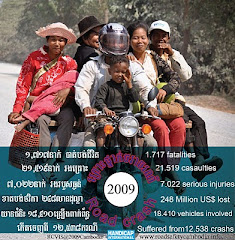WHO News
Half of 1.27 million people who die in road traffic crashes every year are pedestrians, motorcyclists and cyclists, finds new WHO study.
15 JUNE 2009 | GENEVA/NEW YORK -- The first global assessment of road safety finds that almost half of the estimated 1.27 million people who die in road traffic crashes every year are pedestrians, motorcyclists and cyclists. While progress has been made towards protecting people in cars, the needs of these vulnerable groups of road users are not being met.
Related links
Global status report on road safety
WHO programme on road traffic injuries
The Global status report on road safety published today provides the first worldwide analysis of how well countries are implementing a number of effective road safety measures. These include limiting speed, reducing drink-driving, and increasing the use of seatbelts, child restraints and motorcycle helmets. Funded by Bloomberg Philanthropies, the report presents information from 178 countries, accounting for over 98% of the world’s population. It uses a standardized method that allows comparisons between countries to be made.
"We found that in many countries, the laws necessary to protect people are either not in place or are not comprehensive. And even when there is adequate legislation, most countries report that their enforcement is low," said WHO Director-General Dr Margaret Chan. "We are not giving sufficient attention to the needs of pedestrians, cyclists and motorcyclists many of whom end up in clinics and hospitals. We must do better if we are to halt or reverse the rise in road traffic injuries, disability and deaths."
"Traffic crashes are a leading cause of death, particularly among young people 5 to 44 years of age," said Mr Michael R. Bloomberg. "For the first time, we have solid data to hold us accountable and to target our efforts. Road safety must be part of all transport planning efforts, particularly at this moment of focus on infrastructure improvements and road building by many countries around the globe."
Road traffic death rates increasing
While road traffic death rates in many high-income countries have stabilized or declined in recent decades, research suggests road deaths are increasing in most regions of the world and that if trends continue unabated, they will rise to an estimated 2.4 million a year by 2030. In addition, road crashes cause between 20 million and 50 million non-fatal injuries every year and are an important cause of disability. In many countries support services for road traffic victims are inadequate. These avoidable injuries also overload already stretched health-care systems in many countries.
The report documents numbers of registered motorized vehicles in each country and action being taken to invest in public transport and encourage non-motorized travel such as walking and cycling. Vehicle manufacturing standards and requirements for road safety audits were also reported, as well as the existence of formal pre-hospital care systems, including emergency telephone numbers.
Accurate statistics are crucial for understanding the state of road safety and measuring the impact of efforts to improve it. The report found that underreporting of deaths occurs in many countries, and that few countries have completely reliable data on road traffic injuries. The highest death rates are seen in the Eastern Mediterranean and African regions. The lowest rates are among high-income countries, such as the Netherlands, Sweden and the United Kingdom.
Other highlights of the report include:
* Less than a third of countries meet basic criteria for reducing speed in urban areas.
* Less than half of countries use the recommended blood alcohol concentration limit of 0.05 grams per decilitre as a measure to reduce drink-driving.
* While helmet laws exist in more than 90% of countries, only 40% have a law that covers both riders and passengers while also requiring that helmets meet a specified standard.
* Only 57% of countries have laws that require all car occupants to wear seat-belts. This figure is only 38% in low-income countries.
* Half of all countries do not have laws requiring the use of child restraints (e.g., child seats and booster seats). This figure masks considerable variation, with relevant laws in 90% of high-income countries but only 20% of low-income countries.
* Only 15% of countries have comprehensive laws which address all five of these risk factors.
* Where laws on these risk factors are in place they are often inadequately enforced, particularly in low-income countries. For example, only 9% of countries rate their enforcement of speed limits as over 7 on a scale of 0 to 10, while the corresponding figure for enforcement of seat-belt laws is 19%.
“More than 90% of the world’s road deaths occur in low-income and middle-income countries, while these countries only have 48% of the world’s vehicles,” said Dr Etienne Krug, Director of WHO’s Department of Violence and Injury Prevention and Disability. “Our roads are particularly unsafe for pedestrians, cyclists and motorcyclists who, without the protective shell of a car around them, are more vulnerable. These road users need to be given increased attention. Measures such as building sidewalks, raised crossings and separate lanes for two wheelers; reducing drink-driving and excessive speed; increasing the use of helmets and improving trauma care are some of the interventions that could save hundreds of thousands of lives every year."
The report also shows that road traffic injuries remain very relevant in high-income countries. “Even the top performers globally are often stagnating and still have considerable room for improvement in achieving a truly safe road transport system,” Dr Krug said.
For further information contact:
Laura Sminkey
WHO Geneva
Telephone: +41 22 791 4547
Mobile: +41 79 249 3520
E-mail: sminkeyl@who.int
Deftones discography
-
Studio albums: proper source
← Previous revision Revision as of 11:45, 1 September 2025
Line 84: Line 84:
|
|
*RIAA: Platinum
*RIAA: P...
2 hours ago

No comments:
Post a Comment